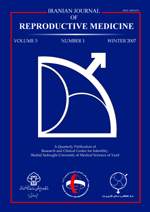
|
International Journal of Reproductive BioMedicine
Research and Clinical Center for Infertility, Shahid Sadoughi University of Medical Sciences of Yazd
ISSN: 1680-6433
EISSN: 1680-6433
Vol. 12, No. 5, 2014, pp. 321-326
|
 Bioline Code: rm14045
Bioline Code: rm14045
Full paper language: English
Document type: Research Article
Document available free of charge
|
|
|
International Journal of Reproductive BioMedicine, Vol. 12, No. 5, 2014, pp. 321-326
| en |
Assessemnt of nasal bone in first trimester screening for chromosomal abnormalities in Khuzestan
Masihi, Sara; Barati, Mojgan; Mohamadjafari, Razieh & Hashemi, Marzieh
Abstract
Background: Fetal nasal bone assessment is a non-invasive procedure that helps provide even greater assurance to patients undergoing their first trimester risk assessment for aneuploidies. Absence or presence of this factor is different in some races.
Objective: The study was aimed to evaluate nasal bone in the first trimester of pregnancy in the indigenous population of Khuzestan Province, and to monitor its value in the diagnosis of chromosomal abnormalities.
Materials and Methods: This study was conducted on 2314 pregnant women between 17-43 years old who referred for first trimester screening for chromosomal abnormalities. Gestational age was between 11-13w + 6 days. Nuchal translucency (NT), fetal heart rate (FHR), crown rump length (CRL), and maternal age and maternal blood serum factors (Free βHCG) and pregnancy-associated plasma protein-A (PAPP-A) and nasal bone were assessed. Finally the risk of trisomies was calculated. The statistical tests are based on the relationship between chromosomal abnormality and the presence or absence of the nasal bone.
Results: In 114 cases we could not examine the nasal bone. Also, in 20 cases missed abortion happened without knowing the karyotype. 2173 cases were delivered normal baby, and in seven cases chromosomal abnormalities were diagnosed. Nasal bone was absent in all three cases with trisomy 21 and six of 2173 cases with normal phenotype (0.3%). With use of the Fisher exact test (p=0.0001), a significant correlation was found between the absence of the nasal bone and the risk of chromosomal abnormality.
Conclusion: Inclusion of the nasal bone in first-trimester combined screening for aneuploidies achieves greater detection rate especially in Down syndrome.
Keywords
Prenatal diagnosis; Nuchal translucency measurement; Maternal serum screening test; Nasal bone
|
| |
© Copyright 2014 - Iranian Journal of Reproductive Medicine
Alternative site location: http://www.ijrm.ir
|
|
